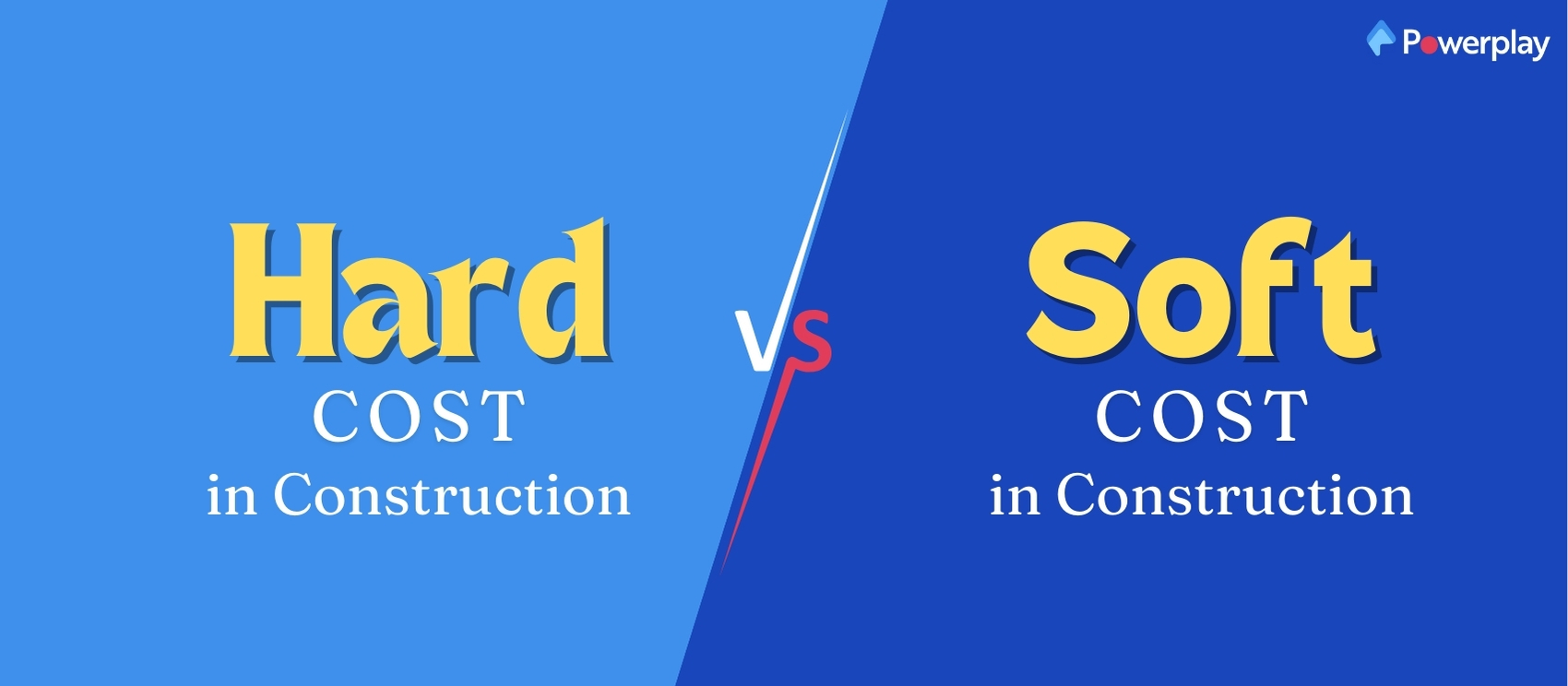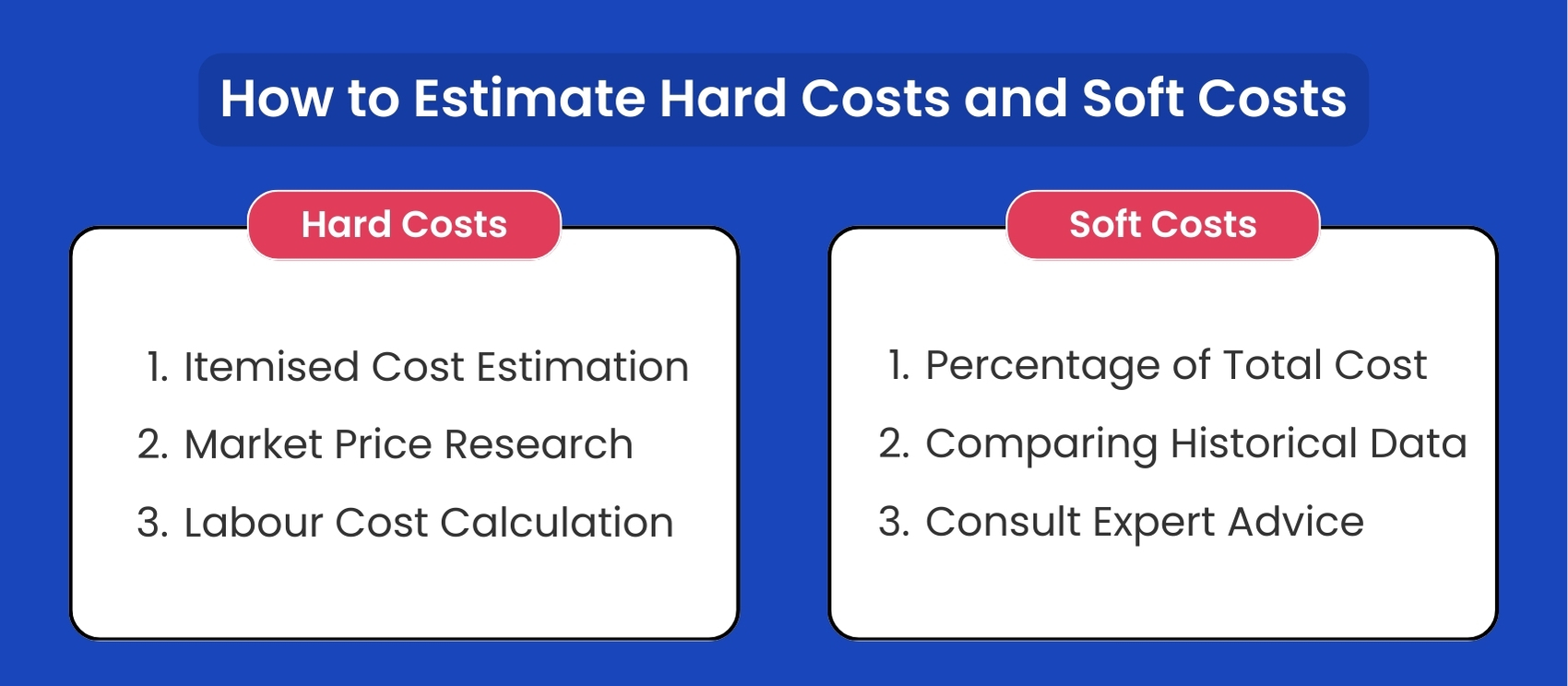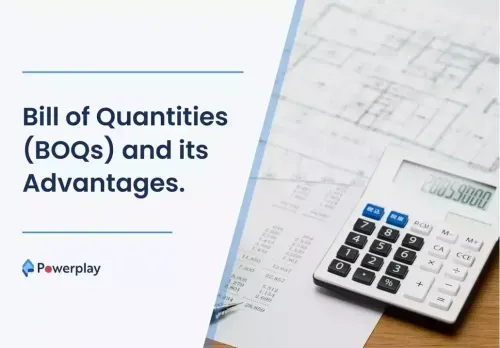Hard Cost vs. Soft Cost in Construction: Definitions and Differences
-
Sapna
- June 15, 2024

Navigating the financial aspects of construction projects requires a deep understanding of the different types of costs involved. In the realm of construction, distinguishing between hard cost vs soft cost is essential for precise budget management and the overall success of any project.

Hard costs relate directly to the physical construction of the project—covering expenses like labour, materials, and equipment—while soft costs encompass indirect expenses such as planning, legal fees, and administrative support. By clearly defining and managing these costs, project managers can ensure a project stays on budget and achieves financial success.
Table of Contents
What are Hard costs?

Hard costs, also known as “tangible costs” or “brick-and-mortar costs,” are direct expenses associated with a project’s physical construction. These are the costs directly related to the building and infrastructure of a construction project, including labour, materials, and equipment. Examples of hard costs include construction labour and landscaping costs. They are often the most significant portion of a construction budget. They are easier to estimate and control compared to soft costs, which are associated with the non-physical aspects of the project.
Raw materials
Raw materials are the essential components used to construct a building or structure. They include cement, steel, wood, bricks, sand, and concrete. These materials form the foundation and framework of any construction project. The quality and cost of raw materials can significantly impact the overall budget and durability of the construction.
Examples:
- Concrete: Used for foundations, walls, and floors.
- Steel: Utilised for structural frameworks, beams, and reinforcements.
- Wood: Employed in framing, roofing, and interior finishes.
- Bricks and Blocks: Essential for walls and partitions.
- Glass: Used for windows, facades, and interior partitions.
Construction labour
Construction labour refers to the workforce required to carry out various tasks on a construction site. This includes skilled and unskilled workers, such as carpenters, masons, electricians, plumbers, and general labourers. Labour costs can differ based on the complexity of the project, the skill level required, and the geographic location of the construction site. Labour costs are a significant factor in predicting project costs, making accurate budget forecasts challenging for construction companies.
Types of Labour:
- Skilled Labour: Workers with specialised training, such as electricians, plumbers, carpenters, and masons.
- Unskilled Labour: Workers who perform general tasks that do not require specialised training, such as moving materials and site cleanup.
Cost Factors:
- Wages: Salaries and workers’ wages can vary based on skill level and location.
- Benefits: Additional costs such as health insurance, pensions, and other benefits provided to workers.
- Overtime: Extra pay for workers who work beyond regular hours
Equipment
Equipment in construction refers to the machinery and tools necessary to complete various tasks. This includes heavy machinery like excavators, bulldozers, cranes, loaders and smaller tools like drills, saws, and hammers. Equipment costs can include purchase, rental, maintenance, and fuel.
Types of Equipment:
- Heavy Machinery: Bulldozers, excavators, cranes, and loaders used for major construction tasks.
- Power Tools: Drills, saws, and mixers used for various construction activities.
- Scaffolding: Temporary structures used to support workers and materials during construction.
Cost Factors:
- Purchase vs. Rental: Buying or renting equipment can affect costs. Renting can be cost-effective for short-term projects, while purchasing may be better for long-term use.
- Maintenance: Regular maintenance is required to keep equipment in good working condition, adding to the overall cost.
- Fuel and Power: The operational cost of equipment, including fuel for machinery and electricity for power tools.
Interior fixtures
Interior fixtures are the permanent components installed inside a building to enhance its functionality and aesthetics. These include lighting fixtures, plumbing fixtures, cabinetry, flooring, and built-in furniture. While they are installed towards the end of the construction process, their costs need to be considered in the overall budget from the beginning.
Examples:
- Lighting: Illumination fixtures, including ceiling lights, wall sconces, and chandeliers.
- Plumbing Fixtures: Sinks, faucets, toilets, and showers provide water and sanitation.
- Cabinetry: Built-in storage solutions such as kitchen cabinets and bathroom vanities.
- Flooring: Materials used for floors, including tiles, hardwood, carpet, and laminate.
Cost Factors:
- Material Quality: Higher-quality fixtures can be more expensive but offer better durability and aesthetics.
- Installation: Labour costs for installing fixtures vary based on complexity and location.
- Customisation: Custom-designed fixtures can increase costs compared to standard, off-the-shelf options.
What are soft costs?

Soft costs refer to indirect expenses not directly associated to the physical construction of a building. Architectural fees are an example of soft costs associated with planning and financing. These costs are associated with a construction project’s planning, administration, and other non-tangible aspects. Soft costs can be more challenging to estimate and control than hard ones because they encompass a wide range of services and fees supporting the overall project.
Planning
Planning involves the initial stages of a construction project, including feasibility studies, architectural design, engineering, and project management. These activities are crucial for laying the groundwork for a successful project, ensuring that all aspects are well thought out and planned before construction begins.
Administration
Administration costs include expenses related to the overall management and operation of the construction project. This can cover the salaries of project managers, administrative staff, office expenses, and other overhead costs that keep the project running smoothly.
Insurance
Insurance costs are necessary to protect the construction project and the parties involved from various risks. Different types of insurance are required to cover potential liabilities, property damage, worker injuries, and other unforeseen events.
Legal fees
Legal fees enclose the costs associated with legal services required for the construction project. This includes contract preparation, review, dispute resolution, compliance with regulations, and other legal matters.
Real estate
Real estate costs involve acquiring the land or property on which the construction will occur. This can include the purchase price, leasing costs, property taxes, and other associated fees.
Property management
Property management costs are incurred for managing and maintaining the property during and after construction. This includes costs for property managers, maintenance staff, and operational expenses to ensure the property is kept in good condition and operates efficiently.
Hard cost vs. soft cost
Understanding the balance between hard and soft costs is crucial for accurate budgeting and financial management in construction projects. Soft construction costs, such as architectural fees, permits, and legal expenses, significantly impact profitability by adding to the overall project expenses.
When Hard Costs and Soft Costs Occur
Hard Costs primarily occur during a project’s physical construction phase. They accumulate once the ground is broken and continue until the project is completed. These costs are typically straightforward to identify as they involve direct payment for labour, materials, equipment, and other expenses related to the tangible aspects of construction.
Soft Costs can occur before, during, and after the physical construction. Before construction, soft costs include design and architecture fees, permits, and pre-construction services. They might also include legal fees, interest payments, and insurance during construction. After completion, soft costs can include marketing, sales, or leasing expenses necessary for the building’s operation.
How to Estimate Hard Cost vs Soft Cost

Estimating Hard Costs:
- Itemised Cost Estimation: Begin with a detailed breakdown of all the project’s physical components, such as materials, labour, and equipment. This can be done through elemental cost analysis or detailed take-offs based on the project’s blueprints.
- Market Price Research: Check current market prices for all required materials and equipment. Adjust for quantity and potential discounts or markups depending on supplier relationships.
- Labour Cost Calculation: Calculate labour costs by considering the number of workers needed, the hours they will work, and the prevailing wage rates. Factor in additional costs like overtime, insurance, and benefits.
Estimating Soft Costs:
- Percentage of Total Cost: Soft costs are often estimated as a percentage of the total construction costs. This percentage can differ widely but typically ranges from 10% to 30% of the total project cost, depending on the complexity and location of the project.
- Historical Data Comparison: Utilise data from similar projects to gauge the potential soft costs. Adjust for differences in project scale, location, and current economic conditions.
- Consult Expert Advice: Engage with architects, engineers, and consultants early in the planning phase to get accurate estimates of design, permitting, and other professional fees.
Tips for estimating construction costs

Here are some enhanced tips for estimating construction costs, incorporating insights from various expert sources:
Prioritise Your Hard Costs:
Hard costs, including materials, labour, and equipment, are directly allied to the physical construction of your project. Since these costs are tangible and easier to estimate, they should be your primary focus during budget planning. Track these expenses meticulously using a project management tool to ensure you stay within your budget.
Consider Many Soft Costs:
Soft costs, though less tangible, can constitute a significant portion of your overall budget, ranging from 25% to 75%. These include architectural and engineering fees, permits, marketing, and legal fees. Given their variability and potential to arise at any project stage, it’s crucial to forecast these costs as accurately as possible and include them in your budget from the outset.
Use Software to Help Track Your Spending:
Implement project management software with features like real-time data tracking, Gantt charts, and budget management tools. Such technology helps monitor both hard and soft costs as they occur, which aids in controlling overspending and keeping the project on track.
Identify Key Risks:
It is crucial to recognise potential financial risks at the beginning of a project. Factors like market volatility, unforeseen site conditions, or regulatory changes can impact your budget. Engage experienced professionals who can use their expertise to provide accurate estimates and help mitigate these risks. Accurate forecasting involves considering past industry benchmarks and ongoing market conditions.
Construction Budget Template
A construction budget template is an essential tool that helps project managers and contractors outline and control the financial aspects of their construction projects. This free template make sures that all project stakeholders are aligned and aware of their financial commitments by providing a clear breakdown of all expected costs. It facilitates proactive expense management, helps prevent cost overruns, and guarantee the project stays within the allocated budget.
Download Free Construction Budget Template
The Importance of Identifying Hard Cost vs. Soft Cost
Understanding the distinction between hard cost vs soft costs is crucial for effective budget management in construction project management. Hard costs, such as labour and materials, directly relate to the physical construction of the project, while soft costs encompass indirect expenses like design fees, permits, and insurance.
The ratio of hard to soft costs can differ significantly across projects, making it essential for project managers to accurately identify and categorise these expenses to ensure a comprehensive budget analysis. Thoroughly analysing both types of costs is fundamental to maximising return on investment and achieving financial success in construction projects.
Effective budget management requires meticulous tracking of all expenses throughout the project lifecycle. This vigilance helps prevent budget overruns on both hard and soft costs. Leveraging construction project management software is vital in this process. Such tools provide real-time monitoring of expenditures, allowing for timely adjustments in project scope, costs, or scheduling to keep the project on track and within budget parameters.
Control Hard and Soft Costs With Powerplay
Real-Time Collaboration and Communication:
Powerplay enhances project success by enabling effective, real-time team collaboration and communication. Its built-in tools for document sharing and messaging make sures that all team members remain aligned and informed.
Mobile Accessibility:
The Powerplay mobile app allows you to stay connected to your projects from anywhere. It makes it easy to access project information, communicate with all the team members, and track progress on the go.
Enhanced Project Management:
Powerplay streamlines project management processes, improving task assignment, progress tracking, and resource allocation. This helps in keeping projects within budget and schedule.
Real-Time Budget Monitoring:
The app offers real-time budget monitoring and cost-tracking features, crucial for maintaining financial control and preventing budget overruns. This allows managers to make informed decisions and manage project finances effectively.
Vendor and Material Management Integration:
Powerplay integrates seamlessly with existing systems to manage vendors and materials efficiently in one place, reducing the risk of errors and improving procurement processes.
Petty Cash Management:
It provides tools to monitor budgets, categorise expenses, and generate comprehensive transactional reports, which are essential for tracking where money is being spent and ensuring transparency.
Conclusion
Understanding the distinction between hard and soft costs in construction is critical for effective project management and budget control. Accurately identifying and categorising these costs ensures a thorough budget analysis, helping project managers maximise their return on investment and manage financial resources efficiently.
Tools like Powerplay can significantly aid in this process by providing real-time monitoring and management capabilities, enhancing collaboration and financial oversight. As projects vary widely, integrating such technologies facilitates better budget adherence and streamlines overall project management, ultimately helping to the success and profitability of construction endeavours.













